#Pierre Shale
Text
I’ve been offered the internship I really wanted <3
I moved to North Dakota kind of on a whim with the dream of being a paleontologist, but this position puts me actually in the paleontology collections (literally my dream job long term) so like. Damn. I guess I’m doing this. I might be able to actually become a paleontologist for real.
#I’m so excited I honestly didn’t dare anticipate getting this position but I really wanted it#I moved to North Dakota so I could work with the dinosaurs and I’m fucking doing it y’all#well. okay. technically I get to work with them to decide what formation and type of fossil I will work with#and if it’s an option I will probably choose Pierre shale marine invertebrates#because god i fucking love ammonites#but in theory I could choose to do dinosaurs#I just. don’t know shit about vertebrate skeletons#but invertebrates are so cool and I love them but other people don’t love them as much#so it might be useful for them to have somebody who wants to focus on them#I’m just very excited because this feels like a step in the right direction and if this goes well my chances of getting into grad school go#way up as well#except I think I want to focus on the actual history part of museum studies in grad#more diverse education background would set me up for more diverse plausible hiring options right out of school#also I love history I would totally be a history major if I didn’t also love geology and want the stability
8 notes
·
View notes
Text
Jormungandr
An albino Jormungandr circles a Ginko adiantoides sapling that was blown into the sea by a recent thunderstorm.
Jormungandr is a recently described genus of mosasaur from the Pierre Shale Fm. described by Zietlow et al., (2023) congrats on the successful publication!

#digital art#paleoart#paleontology#artists on tumblr#digital artwork#palaeoart#digital illustration#id in alt text#sciart#mosasaur#mosasaurid#Jormungandr#norse mythology
563 notes
·
View notes
Text
JORMUNGANDR WALHALLAENSIS: A NEW MOSASAURINE (SQUAMATA: MOSASAUROIDEA) FROM THE PIERRE SHALE FORMATION (PEMBINA MEMBER: MIDDLE CAMPANIAN) OF NORTH DAKOTA
Published 30th October 2023
A new genus and species of mosasaurine mosasaur is discovered, Jormungandr walhallaensis, from the Pierre Shale Formation in Cavalier County in North Dakota consisting of a partial skull and post cranial material.

Skull and jaws of the holotype specimen

Drawing of re-articulated skull from Jormungandr walhallaensis

Reconstruction of Jormungandr walhallaensis engaging in intraspecific combat, artwork by Henry Sharpe.
source:
(Sorry for not uploading for a while, i have been busy and taking some breaks. I will posting as usual now, thank you for your patience.)
43 notes
·
View notes
Text

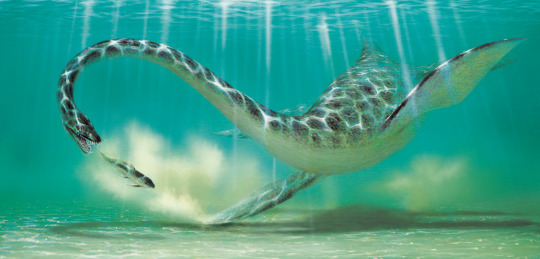



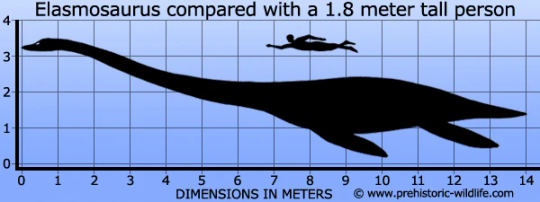
Elasmosaurus platyurus
(temporal range: 80.5 mio. years ago)
[text from the Wikipedia article, see also link above]
Elasmosaurus (/ɪˌlæzməˈsɔːrəs, -moʊ-/;[1]) is a genus of plesiosaur that lived in North America during the Campanian stage of the Late Cretaceous period, about 80.5 million years ago. The first specimen was discovered in 1867 near Fort Wallace, Kansas, US, and was sent to the American paleontologist Edward Drinker Cope, who named it E. platyurus in 1868. The generic name means "thin-plate reptile", and the specific name means "flat-tailed". Cope originally reconstructed the skeleton of Elasmosaurus with the skull at the end of the tail, an error which was made light of by the paleontologist Othniel Charles Marsh, and became part of their "Bone Wars" rivalry. Only one incomplete Elasmosaurus skeleton is definitely known, consisting of a fragmentary skull, the spine, and the pectoral and pelvic girdles, and a single species is recognized today; other species are now considered invalid or have been moved to other genera.
Measuring 10.3 meters (34 ft) in length, Elasmosaurus would have had a streamlined body with paddle-like limbs, a short tail, a small head, and an extremely long neck. The neck alone was around 7.1 meters (23 ft) long. Along with its relative Albertonectes, it was one of the longest-necked animals to have lived, with the second largest number of neck vertebrae known, 72, 4 less than Albertonectes. The skull would have been slender and triangular, with large, fang-like teeth at the front, and smaller teeth towards the back. It had six teeth in each premaxilla of the upper jaw, and may have had 14 teeth in the maxilla and 19 in the dentary of the lower jaw. Most of the neck vertebrae were compressed sideways, and bore a longitudinal crest or keel along the sides.
The family Elasmosauridae was based on the genus Elasmosaurus, the first recognized member of this group of long-necked plesiosaurs. Elasmosaurids were well adapted for aquatic life, and used their flippers for swimming. Contrary to earlier depictions, their necks were not very flexible, and could not be held high above the water surface. It is unknown what their long necks were used for, but they may have had a function in feeding. Elasmosaurids probably ate small fish and marine invertebrates, seizing them with their long teeth, and may have used gastroliths (stomach stones) to help digest their food. Elasmosaurus is known from the Pierre Shale formation, which represents marine deposits from the Western Interior Seaway.
45 notes
·
View notes
Text

A mosasaur jaw of a Tylosaurus sp. from the Pierre Shale in Phillips County, Kansas, USA. The species Tylosaurus proriger and Tylosaurus pembinensis are both described from this deposit; the replacement teeth suggests it belongs to the former.
#mosasaur#fossils#paleontology#palaeontology#paleo#palaeo#tylosaurus#tylosaurinae#mosasauridae#cretaceous#mesozoic#prehistoric#science#paleoblr#ティロサウルス#モササウルス科#化石#古生物学
11 notes
·
View notes
Text
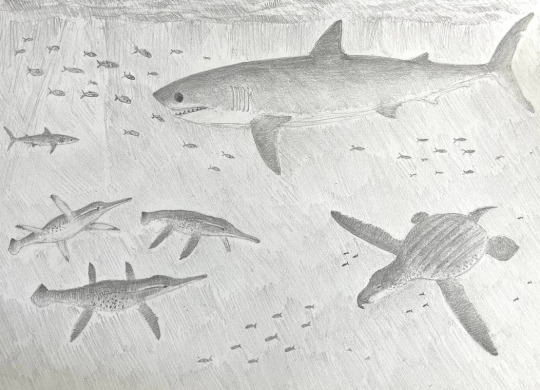
A Morning in Pierre Shale
13 notes
·
View notes
Photo

Pinnacles Overlook .. (2 / 3)[3 / 3]
Badlands National Park, near Wall, SD.
A jungle grew here. Before that, a shallow sea covered the land.
Both are gone now, but both left evidence of their passing.
The sea's signature is ammonites, baculites, and clams, pearly fossils entombed in a fossil mud called the Pierre Shale. This shale is exposed in the gully below you.
A jungle sprang up after the sea drained away about 65 million years ago. For a long time tree roots broke up the shale, and chemicals from decaying plants produced a yellow soil. About 37 million years ago sediment from the west washed over the jungle.
The jungle rebounded, converting the new sedirnent into a red soil. Buried by later sediments, both yellow and red soils were fossilized. We call them the Yellow Mounds Paleosol and the Interior Paleosol.
12 notes
·
View notes
Photo

Pierre Shale Mosasaur vertebrae
3 notes
·
View notes
Text
Meet Snakey McCrocface! Seabeast with long neck and crocodile-like jaws swam oceans 70m years ago
Meet Snakey McCrocface! Seabeast with long neck and crocodile-like jaws swam oceans 70m years ago
A bizarre prehistoric seabeast with a neck longer than a giraffe’s, and a crocodile-like head has been uncovered 70 million years after it stalked the oceans.
The skeleton of the 23-foot creature was discovered in the Pierre Shale in the US state of Wyoming, where there was once a huge inland sea.
Now the predator, whose name Serpentisuchops literally translates to ‘snakey crocodile-face’ has…

View On WordPress
0 notes
Text
The Pierre Shale of the Western Interior Seaway is home sweet home for Tex the Tylosaurus!
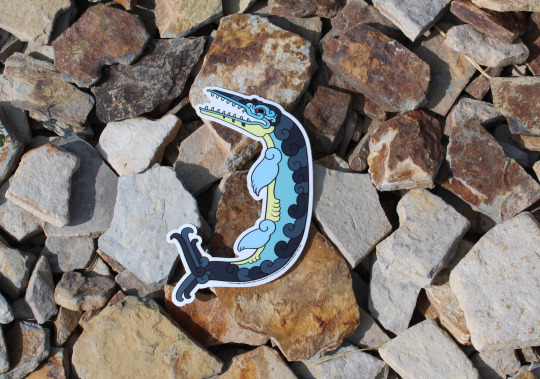
She would also like to find her way home to you! https://paleopals.square.site/#pmGoMz
#tylosaurus#tylosaurus proriger#Sticker#stickers#vinyl stickers#paleoart#cretaceous#western interior seaway#dinosaurs#dinosaur#pierre shale#monarobot#maya#maya style#Maya Art#mesoamerica
19 notes
·
View notes
Text
I am back from the field course! Saw so many cool things and I cannot wait to go back with all of my new knowledge of formations and localities
#today we hit up two of the spots i was most excited for#a Fox hills butte thst exposes the bullhead member#which had tonsss of oysters#it also had ripple marks and some beach facies which was soooooo cool#and then we went hunting for fossil crabs in the Pierre shale at a spot near where I visited to look over the summer#and I found a bunch which is so exciting because I did not find any last time#and some of what we think are root casts which is super cool#honestly it was so fun I’m really glad I went even though I was sick the first three days#masked of course but still quite miserable
3 notes
·
View notes
Photo

Bad movie I have Angel has Fallen 2019
#Angel has Fallen#Millennium Films#Gerard Butler#Frederick Schmidt#Danny Huston#Rocci Williams#Piper Perabo#Harry Ditson#Linda John-Pierre#Ori Pfeffer#Morgan Freeman#Jasmine Hyde#Ian Porter#Laurel Lefkow#Michael Landes#Mark Arnold#Kerry Shale#Tim Blake Nelson#John Strong#Mark Basnight#Jessica Cobley#Maisie Cobley#Jada Pinkett Smith#Joseph Millson#Greg Orvis#Chris Browning#Nick Nolte#Wayne Gordon#Lance Reddick
1 note
·
View note
Text
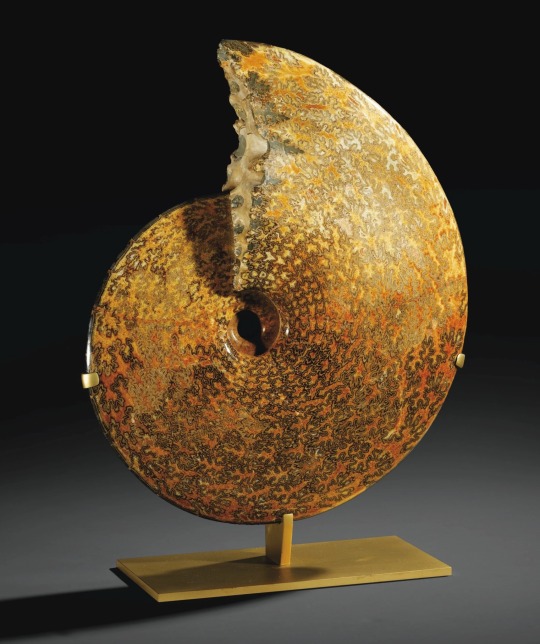
Impressive ammonite Placenticeras intercalare ; Haut crétacé (80 million d'années), Pierre Shale, South Dakota, USA
Sotheby’s
54 notes
·
View notes
Photo

Is an extinct marine turtle from the Late Cretaceous, and is the largest turtle ever to have been documented, with the biggest specimen measuring 460 cm (15 ft) from head to tail, 400 cm (13 ft) from flipper to flipper, and 2,200 kg (4,900 lb) in weight. It is known only from the Dakota Pierre Shale and has one species, A. ischyros. In the past, the genus also contained A. marshii and A. copei, though these have been reassigned to Protostega and Microstega, respectively. The genus was named in 1895 by American paleontologist George Reber Wieland based on a skeleton from South Dakota, who placed it into the extinct family Protostegidae. The leatherback sea turtle (Dermochelys coriacea) was once thought to be its closest living relative, but now, Protostegidae is thought to be a completely separate lineage from any living sea turtle. Archelon had a leathery carapace instead of the hard shell seen in sea turtles. The carapace may have featured a row of small ridges, each peaking at 2.5 or 5 cm (1 or 2 in) in height. It had an especially hooked beak and its jaws were adept at crushing, so it probably ate hard-shelled crustaceans and mollusks while slowly moving over the seafloor. However, its beak may have been adapted for shearing flesh, and Archelon was likely able to produce powerful strokes necessary for open-ocean travel. It inhabited the northern Western Interior Seaway, a mild to cool area dominated by plesiosaurs, hesperornithiform seabirds, and mosasaurs. It may have gone extinct due to the shrinking of the seaway, increased egg and hatchling predation, and cooling climate.
Omnivore
Art (c) reneg661
2 notes
·
View notes
Text
Behind the Scenes with the Baron de Bayet and L. W. Stilwell Collection Part 3: The Wild West Formed Million of Years Ago

Figure 1: Badland National Park Today, National Park Service photo, 2014. This view of the Badlands topography illustrates the erosion that took place over the last 2 million years.
The Lakota called the badlands “Mako Sica” or “land bad.” The early French-Canadian trappers referred to it as “les mauvais terres pour traverse” or “bad lands to travel through.” Seventy-five million years ago, this area was a lush underwater seaway filled with creatures such as mosasaurs, plesiosaurs, diving birds, fish, baculites, and ammonites (Figure 2).
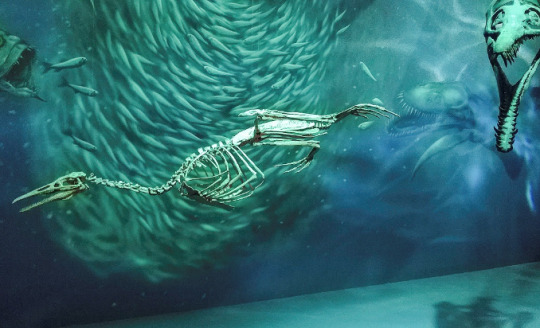
Figure 2: Taxa that swam in the Western Interior Seaway from Dinosaurs In Their Time exhibit at Carnegie Museum of Natural History. Photo by Patty Dineen.
The Stilwell fossils of Cretaceous age (Figure 3) were deposited in a black mud that accumulated on the sea floor from 82 to 70 million years ago (Figure 4). The Pierre Shale is part of the extensive Western Interior Seaway of North America (Figure 5). Museum visitors can view a changing geographic representation of the seaway on a wall-mounted flat screen monitor within the Dinosaurs in Their Time exhibit. The seaway extended from the Gulf of Mexico, Florida, and southern Gulf Coast, north through Texas, Kansas, Colorado, Wyoming, Montana, the Dakotas, and the Canadian Provinces of Alberta and Saskatchewan. This vast waterway terminated in the Artic region of Canada. At the time of the Pierre Sea, the ice sheet-free greenhouse to hothouse paleoclimate was much warmer than it is today, creating the highest sea levels in earth’s history. Sea level rises and falls were primarily controlled by the presence or melting of glaciers in the polar regions, the shifting of the continents, and the uplifting of proto-Rocky Mountains by plate tectonics.
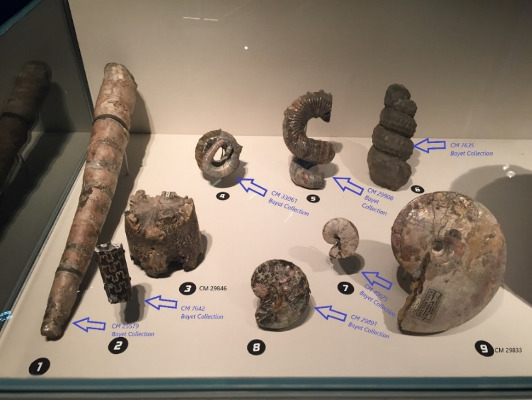
Figure 3: Western Interior Seaway fossils on display at Carnegie Museum's Dinosaurs in Their Time exhibit. Stilwell fossils are highlighted in blue.

Figure 4: Outcrop photo of Pierre shale.

Figure 5: Western Interior Seaway approximately 75 million years ago. Red dot locates Deadwood, South Dakota today.
Fast forward to the Wild West of the 1890’s, and dealers such as Stilwell found and sold fossils to museums and private collectors. Knowledge of Badlands fossils spread as far as Europe, and by 1889 Bayet wanted some for his own collection.
Next, in our final post of this series, we will delve into the Stilwell-Bayet correspondence in search of clues about how fossils were bought and sold over a century ago.
Joann Wilson is an Interpreter for the Department of Education and a volunteer with the Section of Invertebrate Paleontology. Albert Kollar is Collections Manager for the Section of Invertebrate Paleontology. Museum employees are encouraged to blog about their unique experiences and knowledge gained from working at the museum.
#Carnegie Museum of Natural History#Baron de Bayet#Invertebrate Paleontology#Paleontology#Wild West#LW Stilwell
22 notes
·
View notes
